Kerosene, or paraffin, is a combustible hydrocarbon liquid which is derived from petroleum. It is widely used as a fuel in aviation as well as households. Its name derives from Greek: κηρός (kērós) meaning "wax", and was registered as a trademark by Nova Scotia geologist and inventor Abraham Gesner in 1854 before evolving into a generic trademark. It is sometimes spelled kerosine in scientific and industrial usage.
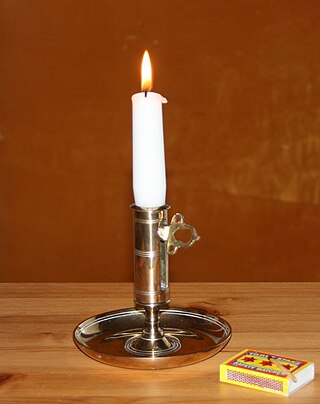
A candle is an ignitable wick embedded in wax, or another flammable solid substance such as tallow, that provides light, and in some cases, a fragrance. A candle can also provide heat or a method of keeping time.

A kerosene lamp is a type of lighting device that uses kerosene as a fuel. Kerosene lamps have a wick or mantle as light source, protected by a glass chimney or globe; lamps may be used on a table, or hand-held lanterns may be used for portable lighting. Like oil lamps, they are useful for lighting without electricity, such as in regions without rural electrification, in electrified areas during power outages, at campsites, and on boats. There are three types of kerosene lamp: flat-wick, central-draft, and mantle lamp. Kerosene lanterns meant for portable use have a flat wick and are made in dead-flame, hot-blast, and cold-blast variants.
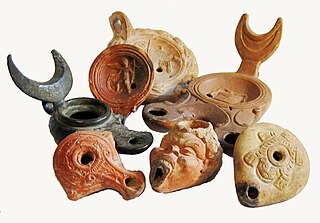
An oil lamp is a lamp used to produce light continuously for a period of time using an oil-based fuel source. The use of oil lamps began thousands of years ago and continues to this day, although their use is less common in modern times. They work in the same way as a candle but with fuel that is liquid at room temperature, so that a container for the oil is required. A textile wick drops down into the oil, and is lit at the end, burning the oil as it is drawn up the wick.

Motor oil, engine oil, or engine lubricant is any one of various substances used for the lubrication of internal combustion engines. They typically consist of base oils enhanced with various additives, particularly antiwear additives, detergents, dispersants, and, for multi-grade oils, viscosity index improvers. The main function of motor oil is to reduce friction and wear on moving parts and to clean the engine from sludge and varnish (detergents). It also neutralizes acids that originate from fuel and from oxidation of the lubricant (detergents), improves the sealing of piston rings, and cools the engine by carrying heat away from moving parts.

A portable stove is a cooking stove specially designed to be portable and lightweight, used in camping, picnicking, backpacking, or other use in remote locations where an easily transportable means of cooking or heating is needed. Portable stoves can be used in diverse situations, such as for outdoor food service and catering and in field hospitals.

A lantern is an often portable source of lighting, typically featuring a protective enclosure for the light source – historically usually a candle, a wick in oil, or a thermoluminescent mesh, and often a battery-powered light in modern times – to make it easier to carry and hang up, and make it more reliable outdoors or in drafty interiors. Lanterns may also be used for signaling, as torches, or as general light-sources outdoors.

A lighter is a portable device which creates a controlled flame, and can be used to ignite a variety of flammable items, such as cigarettes, butane gas, fireworks, candles or campfires. A lighter typically consists of a metal or plastic container filled with a flammable liquid, a compressed flammable gas and in rarer cases a flammable solid i.e. rope in a trench lighter, a means of ignition to produce the flame, and some provision for extinguishing the flame or merely controlling it to such a degree that the user may extinguish it with their breath. Alternatively, a lighter can be one which uses electricity to create an electric arc utilizing the created plasma as the source of ignition or a heating element can be used in a similar vein to heat the target to its ignition temperatures, as first formally utilized by Friedrich Wilhelm Schindler to light cigars and now more commonly seen incorporated into the automobile auxiliary power outlet to ignite the target material. Different lighter fuels have different characteristics which is the main influence behind the creation and purchasing of a variety of lighter types.

A rushlight is a type of candle or miniature torch formed by soaking the dried pith of the rush plant in fat or grease. For several centuries, rushlights were a common source of artificial light for poor people throughout the British Isles. They were extremely inexpensive to make. English essayist William Cobbett wrote, "This rushlight cost almost nothing to produce and was believed to give a better light than some poorly dipped candles."
Whale oil is oil obtained from the blubber of whales. Oil from the bowhead whale was sometimes known as train-oil, which comes from the Dutch word traan.
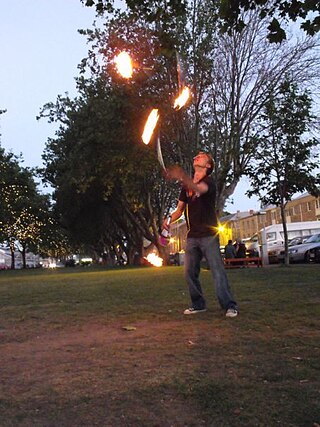
Juggling torches are one of various props used by jugglers. Torches are usually commercially made props that are made of wood and/or metal with a wick attached at one end. The wick is soaked in liquid fuel, usually paraffin and ignited before use.
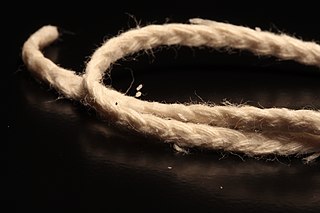
A candle wick or lamp wick is usually made of braided cotton that holds the flame of a candle or oil lamp. A candle wick works by capillary action, conveying ("wicking") the fuel to the flame. When the liquid fuel, typically melted candle wax, reaches the flame it then vaporizes and combusts. In other words, the wick brings the liquified wax up into the flame to burn. The candle wick influences how the candle burns. Important characteristics of the wick include diameter, stiffness, fire-resistance, and tethering.
Vegetable oil can be used as an alternative fuel in diesel engines and in heating oil burners. When vegetable oil is used directly as a fuel, in either modified or unmodified equipment, it is referred to as straight vegetable oil (SVO) or pure plant oil (PPO). Conventional diesel engines can be modified to help ensure that the viscosity of the vegetable oil is low enough to allow proper atomization of the fuel. This prevents incomplete combustion, which would damage the engine by causing a build-up of carbon. Straight vegetable oil can also be blended with conventional diesel or processed into biodiesel, HVO or bioliquids for use under a wider range of conditions.
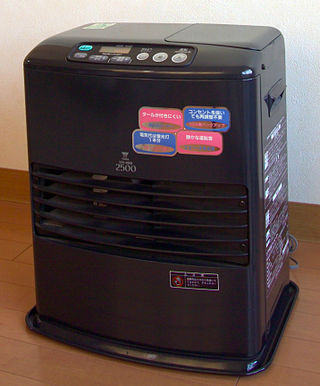
A kerosene heater, also known as a paraffin heater, is typically a portable, unvented, kerosene-fueled, space heating device. In Japan and other countries, they are a primary source of home heat. In the United States and Australia, they are a supplemental heat or a source of emergency heat during a power outage. Most kerosene heaters produce between 3.3 and 6.8 kilowatts.

The Argand lamp is a type of oil lamp invented in 1780 by Aimé Argand. Its output is 6 to 10 candelas, brighter than that of earlier lamps. Its more complete combustion of the candle wick and oil than in other lamps required much less frequent trimming of the wick.

A tealight is a candle in a thin metal or plastic cup so that the candle can liquefy completely while lit. They are typically small, circular, usually wider than their height, and inexpensive. Tealights derive their name from their use in teapot warmers, but are also used as food warmers in general, e.g. fondue.

A grease fitting, grease nipple, Zerk fitting, grease zerk, or Alemite fitting is a metal fitting used in mechanical systems to feed lubricants, usually lubricating grease, into a bearing under moderate to high pressure using a grease gun.

In fire classes, a Class B fire is a fire in flammable liquids or flammable gases, petroleum greases, tars, oils, oil-based paints, solvents, lacquers, or alcohols. For example, propane, natural gas, gasoline and kerosene fires are types of Class B fires. The use of lighter fluid on a charcoal grill, for example, creates a Class B fire. Some plastics are also Class B fire materials.

The moderator lamp is a type of 19th century oil lamp. It displaced the more complex Carcel lamp which used a clockwork pump. Its mechanism was simpler and required less maintenance or repair. The moderator lamp was invented in 1837 by Charles-Louis-Félix Franchot (1809-1881). Like the Carcel lamp the oil reservoir was below the burner and it allowed 360 degree illumination. Earlier oil lamps such as the Argand had a reservoir above the burner which made them top heavy and obscured some of the light. The reliability of the mechanism led to them being adopted in lighthouses.
















